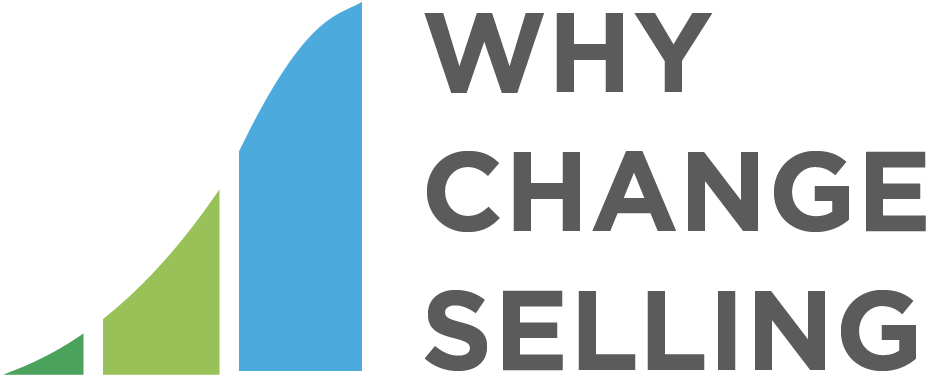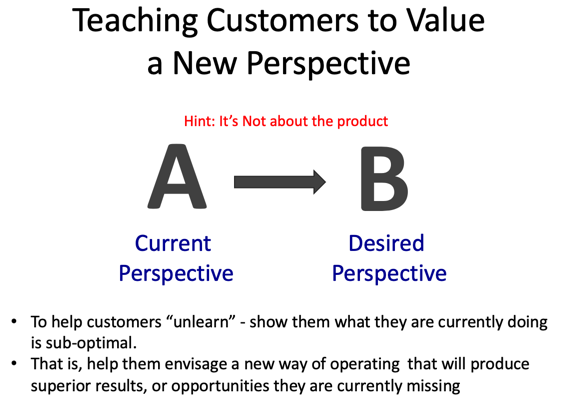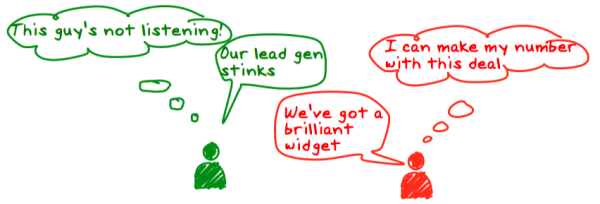People ask me this question when they are curious about creating whiteboards, and the truth is that it depends on your purpose and desired outcome. In this article, I discuss whiteboard types and their purpose and a process for creating a whiteboard story.
4 min read
How Much Does a Whiteboard Story Cost to Create?
By Mark Gibson on Mon, Sep 30, 2019
Topics: consultative selling challenger selling storytelling whiteboard storytelling commercial insight
15 min read
Challenger, Insight and Consultative Selling vs. Transactional Sales
By Mark Gibson on Wed, Dec 19, 2012
10 Trends every Sales Exec Must Know for 2013 - CEB
This is the second part of the CEB article published several weeks ago, entitled "10 Trends Every Sales Exec Must Know For 2013"
This is an important article and worth reading. The remaining 5 points excerpted for our discussion below, were published in this article on the CEB main blog, The Last 5 Trends Every Sales Exec Must Know for 2013.
The key insights in this current article:
6. Your customer becomes your biggest competition.
More specifically, your customer’s ability to learn what their business needs are, and options to act on those needs. We call this the “1 in 3” problem and here’s why: customers that are now able to learn on their own (or with a consultant’s support) are also able to arrive at a requirement set without supplier input. For example, they dictate the uptime requirements, the performance thresholds, the expected SLA's, and other criteria. They winnow a list of potential suppliers down to the top 3 that best meet these performance thresholds. Then they call you in to present. Congrats you’re in the consideration set! And so what do you do? You highlight your performance against their criteria. “Well we see that you require 95% uptime, we can deliver 98%. And we see that you need 30,000 units output, but our innovative technology delivers 33,000.” To which the customer replies, “yes, we already know that, but we only need 95% uptime and 30,000 units output, and all the companies in consideration deliver that. So……let’s talk price.” In this world, consideration equals commoditization. There are two vitally important takeaways from this trend:First, this underscores why the Insight Selling Method™ is so important. Insights which you can teach customers are differentiated, and have the ability revise the purchase criteria, mitigating the “1 in 3” problem. I’ve discussed this in trend #1 and my colleague Brent Adamson has explored this challenge extensively here (this is another must read once you’ve finished this post).
Second, this highlights how the customer has taken this new information advantage and used it (as they should) to their benefit. If they can rely on social networks and third party consultants to force us into a price war, they’d be foolish not to do that.
We are losing this information game to customers.
The best sellers, however, are taking this information disparity right back to customers. Our data shows us that the best reps are conducting deep opportunity/account due diligence with one specific goal: learn something about customers that the customers themselves haven’t realized. This isn’t information in the public filing statement, annual review, or company website.
This is information that exists in the deep inner workings of customer organizations. Information that “Talkers” dish out. Information that purchase consultants divulge. [NOTE: This is NOT unethical information or insider secrets.] It is a much deeper understanding of what’s happening in the customer business that often requires outside intervention to even realize. When this context is combined with powerful insights, customers have little choice but to at least listen and learn from suppliers. And that mitigates the “1 in 3” challenge. Sellers who choose to arbitrarily “spray” insights at customers risk harming the relationship permanently, but those who properly tailor those insights in a meaningful and economically-grounded ways will beat the “1 in 3” problem.
Salespeople in the future will behave more like consultants
We have heard and seen plenty of horror stories of sales reps spraying insights that have no relevance to the problems or goals of the customer or their organization. This is just poor preparation and poor technique. Challenger or not, these reps are on the path to exiting the profession without coaching, new tools, techniques and behavior change.True insights require deep knowledge of the customers business that cannot be easily derived from public sources....it has to come from within. This means due diligence could take weeks - instead of a few hours prior to a sales call with a key executive. Sourcing insightful information from peers, outsiders, former employees, underlings and even corporate purchasing....anyone that could help give you insight. Dominic Rowsell refers to this as a "deep-dive into the World of the buyer" in his book Why Killer Product's Don't Sell, which analyzes the new buyer behavior and defines value-created selling as the way to engage buyers early in the buying cycle, when they may be unaware of the opportunity or are researching directions, ideas and risks in the Identify and Mentor phases of the IMPACT buying cycle.
Value Created Selling Definition: The supplier reveals unforeseen risk or opportunity for the customer (thus creating new value for them) and will assume some kind of responsibility to realize the return.
Topics: challenger selling insight selling value creation selling
2 min read
Consultative Selling Secrets – and other myths
By Mark Gibson on Tue, Jul 24, 2012
Consultative Selling Myths
Sales books, blog-posts and training courses that offer “consultative selling secrets” and magical closing-techniques, constantly amuse me.Most of the ideas in these so-called secrets are common sense and have been in practice since the “Fuller-brush man” came a calling.
If there truly were secrets to success in consultative selling or any other form of selling, then nobody would know them. Another myth is "Consultative Selling is Dead", but I will deal with that one another time...clearly it is not.
The truth is that there is a growing body of knowledge around consultative selling best-practices that anyone with a Web browser and an ability to read can access.
Great sales people are great communicators with strong ego-drive and the self-discipline, to do on a daily basis the little things that average sales people do not, that lead to successful sales outcomes.
Consultative Selling Discipline
What really matters in consultative selling and professional selling in general are the understanding, mastery and daily practice of the following disciplines, skills and techniques;- A genuine desire to succeed (fire-in-the-belly) fuelled by realistic short and long term goals which extend beyond your immediate sales goals. (this is no secret)
- An ability to control your emotional state; - your physiology, language and focus to produce the results you are seeking
- An ability to communicate and to develop rapport with anyone (there are naturals, but these skills can be learned by anyone except those with certain types of autism)
- Learning to listen clearly to what people are saying. This means listening for comprehension first, not for clues to competitors or to disqualify. Then to drill through the intellectual smoke-screen and fluff to understand meaning and intent (the use of language and the ability to listen are skills that can be easily learned)
- A curiosity to learn and discover what makes people tick and to synthesize new ideas to expand your view and appreciation of the World you live-in.
- Diagnostic skills underpinned by the use of best-practices questions that can be learned, which will enable you to chunk the buyer up to get the big picture or chunk down for specificity.
- Strong qualification after each meeting, which commits the buyer to acknowledge they are in agreement with your assessment of their situation and to proceed with agreed next steps
- Formal sales process which commits the buyer at each step of the sales cycle to disqualify non-buyers early and enable accurate forecasting
- Disciplined use of CRM, Knowledge Management and Performance Support tools.
- A reciprocal commitment (give to get) from the buyer at every interaction from asking for a demonstration to negotiating an agreement.
- An understanding of the buying process and tools and technique to help move the buyer through the Positioning phase (where most opportunities die) in the universal buying process I-M-P-A-C-T
- Add to this list, a knowledge of the buyer's business and industry
knowledge, that enables the sales person to come the table as an equal and bring insight and an opnion that challenges the status-quo and gets the buyer thinking differently about their issues and your capabilities.
Topics: killer products consultative selling listening skills challenger selling
3 min read
The Challenger Sale - Who paid for your last sales call?
By Mark Gibson on Tue, Dec 20, 2011
What Price or Value was your last Sales Call?
Would your prospect have paid you for the value they received from meeting with you or one of your sales executives on your last call with them?This is a vexing question and it's one of many vexing questions that have been on my mind since I read the "Challenger Sale". It's a question that should be keeping B2B sales enablement professionals, sales managers and sales professionals up at night.
This question is vital in a World where buyers can find everything they need to know about your products and services without having to speak to you.
On your last call, did you bring the gift of knowledge and insight? Did you educate the buyer on an industry issue or sub-optimal condition that you are aware of because of your domain expertise, view of the market, knowledge of their company and your unique understanding of how your capabilities can create value?
Alternatively, would the buyer have invoiced you for 40 minutes of their time that they felt you robbed from them on your last sales call because you occupied their time, but failed to bring any value?
I will introduce a couple of related concepts to begin to address the value of the sales call question.






